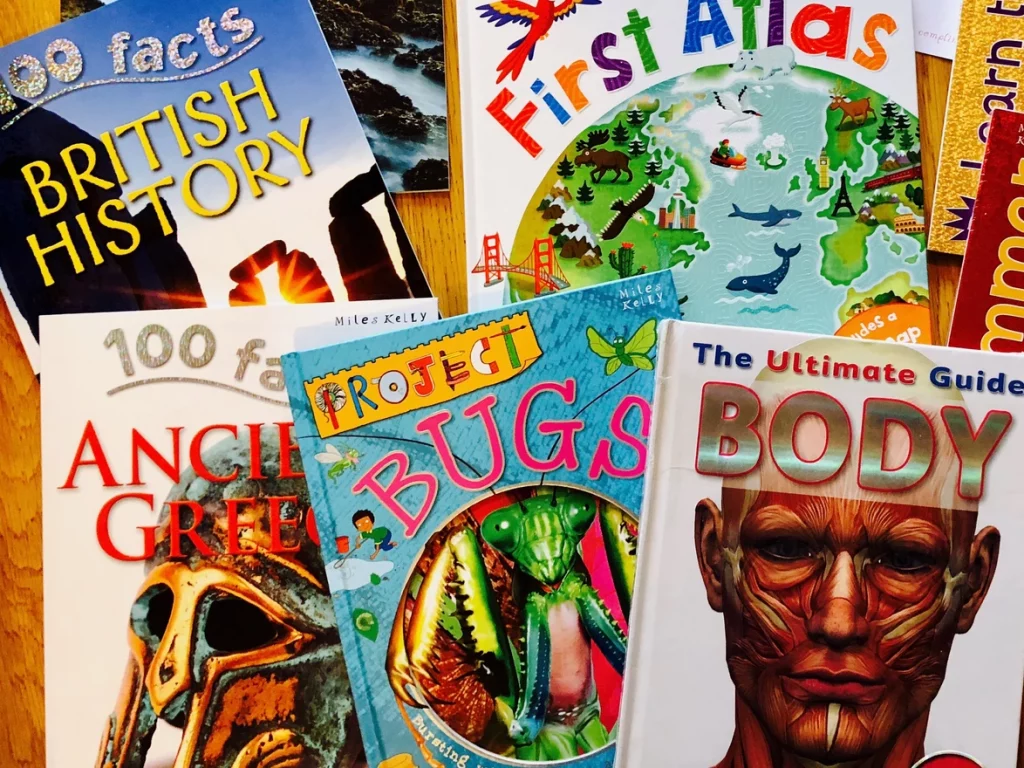BooksforTopics Reading for Pleasure Recommendations
Book Series Titles: ‘Project…’, ‘Ultimate Guide’ & ‘100 Facts’
Author: Various
Publisher: Miles Kelly
Suitable For: KS2
Over the last month we’ve been poring over some of the engaging non-fiction ranges from the Miles Kelly catalogue (you can view the catalogue here). From pop-up books to encyclopaedias to children’s question & answer books, there appears to be non-fiction here to suit all ages and tastes. In this blog post I will review three of the popular non-fiction ranges from Miles Kelly: ‘Project…’, ‘Ultimate Guide’ and ‘100 Facts’.
Like most primary teachers I love non-fiction texts with interactive elements and the ‘Project…’ series is full of them. Titles include ‘Project Egyptians’, ‘Project Space’ and ‘Project Dinosaur’, but here at BooksForTopics HQ we have particularly enjoyed reading ‘Project Bugs’. This book is crammed with colourful fold-out pages, exciting hands-on projects and secret flaps that are cleverly integrated into the photographs (like insects’ wings or cells in a beehive that lift up to reveal extra information). Bursting with interesting facts and ideas for investigative activities, such as finding out how some insects can walk on water, this text delves into the biology of a whole host of fascinating mini-beasts. I particularly recommended this series for KS2 readers who love to explore the world by touching, investigating and discovering things for themselves, as the interactive elements provide a bridge between words on the page and the experience of the reader.
Next I moved on to the ‘Ultimate Guide’ series, which are more comprehensive information
guides suitable for older readers or for pupils who are ready to digest a larger bank of facts presented in a mature style. ‘Ultimate Guide: Body’ by Kristina Routh, for example, contains a detailed breakdown of what goes on inside the human body. Well-pitched for upper KS2, the text holds a wealth of information organised into accessible bullet points, clear photographs, pull-out wall posters and very detailed diagrams.
The structure into 5 key sections makes it easy to find information quickly and I particularly liked the acetate sheet overlays that display different layers over the top of each other. A useful support for learning about human biology in KS2. Other titles in this series include ‘The Ultimate Guide: Ocean’ and ‘The Ultimate Guide: Animal’.
Finally I looked at the ‘100 Facts’ series, which is already well known in many primary classrooms and deservedly so. The ‘100 facts’ books are brilliant for building a foundation of knowledge on a given topic. Each page contains a handful of related facts linked by a main
theme, with the pages cleverly building on each other to develop a rounded overview of the main topic. The facts in the books are coupled with engaging images including photographs and diagrams to help young readers to visualise the information, as well as suggestions of activities to encourage further engagement.
For example, in ‘100 Facts: Planet Earth’ by Peter Riley, the page about volcanoes features four paragraph-long facts relating to volcanoes, a labelled diagram of a cross-section of a volcano, a photograph of pillow lava, three illustrations of different volcano types and instructions for a make-your-own-volcano project. While the concept of a list of 100 snippets of information has the potential to make very dry reading, these books are visual and engaging, made highly suitable for KS2 by the accessible language and the selection of interesting facts that work together to construct a foundation of knowledge about the given topic.
There are already an impressive 82 books in this series so it is easy to find titles that match most topics taught at KS2, with more new titles being added each year.
Taking time to pore over different styles of non-fiction texts, without a particular fact-finding agenda, is also a wonderful reading for pleasure activity in itself and one that finds itself neglected in favour of reading fiction. If you are looking for new non-fiction titles for primary school libraries, I recommend exploring some of the Miles Kelly ranges and here at BooksForTopics we will certainly be keeping an eye for more from this publisher to come.
———–
Find the titles mentioned above on Amazon:
Thank you to the publisher for kindly providing a variety of review copies from its non-fiction ranges.









